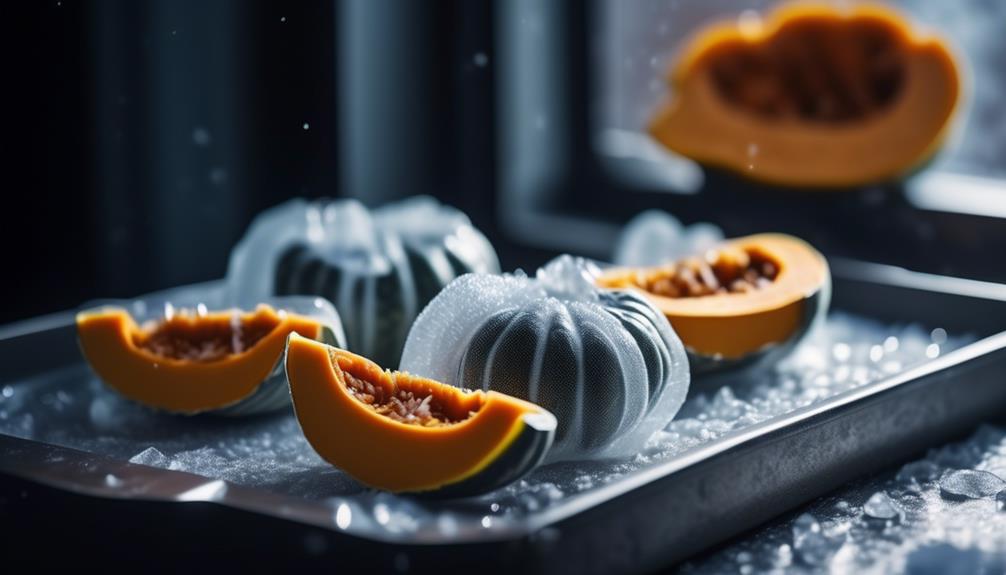In the era of iceboxes and root cellars, preserving the harvest bounty of kabocha squash would've been a seasonal conundrum, but today, you've got the advantage of modern freezing technology at your fingertips.
To ensure your kabocha squash retains its delightful texture and sweet, nutty flavor after thawing, it's crucial to prepare and freeze it properly.
Start by selecting a squash that feels heavy for its size, with a firm, matte skin, free of soft spots or blemishes.
Before you send your kabocha into its chilly slumber, you'll need to clean, cut, and blanch it—steps that are essential in maintaining quality.
As you master the art of quick freezing, you'll be able to enjoy a taste of autumn well into the colder months.
Yet, there are a few subtleties in the process that can make all the difference between a just-okay defrosted squash and one that's as good as fresh.
Key Takeaways
- Select kabocha squash with a deep green rind and firm, heavy feel
- Blanch the squash pieces in boiling water for 2-3 minutes, then transfer to an ice water bath
- Quick freeze the blanched squash pieces on a baking sheet before transferring to airtight freezer bags
- Store the frozen squash in airtight containers or freezer bags, and thaw slowly in the refrigerator before reheating
Selecting the Perfect Kabocha
To select the perfect kabocha squash for freezing, look for one with a deep green rind and a firm, heavy feel for its size. This Japanese pumpkin, a favorite among squash varieties, is renowned for its sweet flavor and velvety texture. You'll find the best quality kabocha during the harvest season, which typically spans from late summer to mid-fall.
When you're at the market or in your garden, give the squash a gentle tap. You're listening for a hollow sound, indicating it's ripe and ready for long-term storage. Check the stem, too; it should be intact and dry, suggesting the kabocha was harvested at the right time and has been cured properly, enhancing its storage potential.
Preparing Your Squash
Once you've selected a ripe kabocha with a satisfying hollow sound, it's time to get it ready for the freezer. The key to a good freeze is all in the preparation. You'll want to start by giving your squash a good wash to remove any dirt or debris from the skin.
Now, let's tackle the cutting and seed removal:
- Cutting tips: Use a sturdy, sharp knife. Kabocha squash can be tough, so place it on a stable surface and carefully cut it in half from stem to base. If the squash is particularly hard, you can soften it slightly by microwaving it for a couple of minutes.
- Seed removal: Once the squash is halved, use a spoon to scoop out the seeds and stringy insides. Be thorough, as leftover seeds can affect the texture when thawed.
- Sectioning: After the seeds are removed, slice the kabocha into manageable pieces. This could mean wedges or cubes, depending on your preference and intended use. Remember, uniform sizes mean even freezing and cooking later on.
Get all your pieces as even as possible, and you're a step closer to having beautifully frozen kabocha squash at your disposal whenever you need it.
Blanching Kabocha Pieces
Before you stash your kabocha squash pieces in the freezer, blanching them is a crucial step to preserve their texture and flavor. This process involves briefly boiling the squash pieces and then plunging them into ice water to halt the cooking. Blanching helps maintain the vibrant color and nutrients, which are essential for enjoying the best quality kabocha later on.
Start by bringing a large pot of water to a rolling boil. While you're waiting, prepare a bowl of ice water. Once the water is boiling, carefully add your kabocha squash pieces and let them cook for about two to three minutes. You're not trying to cook them through, just giving them a quick heat shock.
After the short boil, use a slotted spoon to transfer the squash directly into the ice bath. This stops the cooking process immediately, preserving that tender-crisp quality that makes kabocha so delightful. Let the squash cool in the ice water for the same amount of time they were in the boiling water.
If you're exploring blanching alternatives or dealing with different squash varieties, steam blanching is another option. It's gentler on the squash and can prevent it from becoming too soft. However, for kabocha's dense flesh, traditional water blanching works perfectly.
Once blanched, drain the pieces well, and they're ready to be packed up for freezing.
Quick Freezing Technique
After blanching and draining your kabocha squash, spread the pieces out on a baking sheet in a single layer to initiate the quick freezing process. This method, while simple, is effective in preserving the squash's texture and flavor. Make sure there's space between the pieces to prevent them from sticking together, which allows for even freezing.
Here's what you need to do next:
- Place the Tray in the Freezer: Set the baking sheet in the freezer and leave it undisturbed for a few hours until the kabocha pieces are fully frozen.
- Transfer to Freezer Bags: Once the pieces are individually frozen, quickly transfer them to airtight freezer bags. This minimizes exposure to air, which can lead to freezer burn.
- Vacuum Seal (Optional): For added protection, consider vacuum sealing the bags. Vacuum sealing benefits include a longer shelf life and prevention of ice crystal formation, which is a common issue with freeze drying alternatives.
Freezing your kabocha squash using this quick freeze technique ensures you'll have ready-to-use pieces for your future meals. Remember to label your bags with the date of freezing, and you'll enjoy the convenience and taste of your preserved squash for months to come.
Storing and Thawing Tips
Now that your kabocha squash is securely frozen, let's focus on how to store it properly and the best ways to thaw it when you're ready to use it. Optimal containers for prolonged storage are key to maintaining the quality of your squash. Airtight containers or heavy-duty freezer bags are your best bet. These will protect your kabocha from freezer burn and flavor loss. Make sure to remove as much air as possible before sealing to keep it fresh.
When it's time to thaw, you've got options depending on your timeline and intended use. For a slow thaw, transfer the squash to the refrigerator a day before you plan to use it. This gentle method helps preserve texture. If you're in a hurry, you can use the microwave. Just place the frozen squash in a microwave-safe dish and use the defrost setting, checking frequently to prevent it from cooking.
As for reheating methods, feel free to steam, bake, or microwave the squash until it's heated through. Each method will work well, but remember that slower reheating can help maintain the squash's texture and flavor. Whichever way you choose, you'll have a delicious kabocha ready to enhance your meals.

